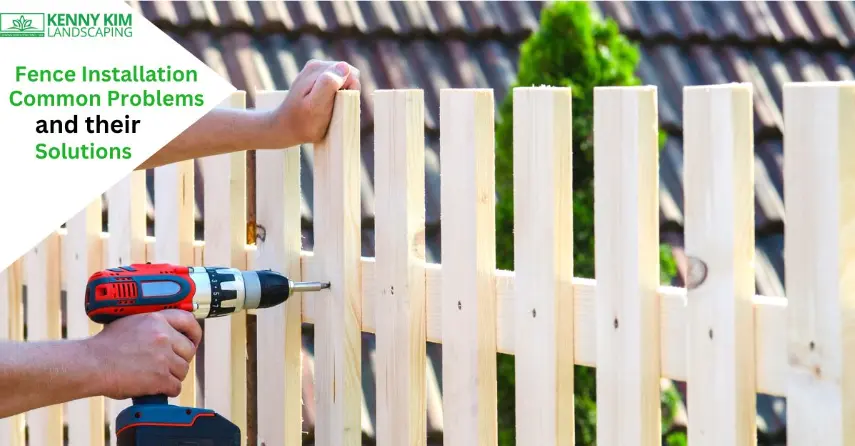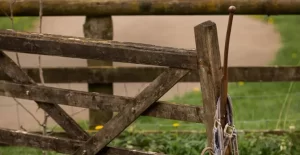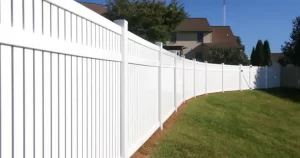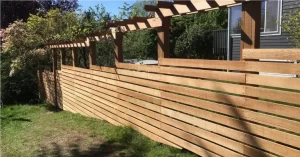Fences are some of the most significant investments you will ever make to raise the worth, safety, and seclusion of your property. You could eliminate the complication and added cost that comes with it when you know how to deal with common fence installation problems.
Proper installation is the first step in making sure the fence functions just as it should for many years. Although evolving techniques and materials can help, installation challenges still arise in 2024. Knowing how to deal with such problems, from poorly laid plans to material defects, is critical to avoid long-term problems.
Among the many issues, wood fence installation issues are particularly common. Rotting of wood, uneven posts and poor sealing are some of the problems which will affect the durability and appearance of the fence. Such problems should be treated as soon as possible to avoid worse damage and to prolong the life of your wood fence.
The following are some practical solutions to the most common problems and issues related to fence installations. By following expert tips, you will avoid costly mistakes, which will result in a successful, durable fence. These will help you from installation to maintenance in bringing out the best results in your fence.
Mistakes in Fence Installation
Mistakes in fence installation can lead to significant issues and extra costs. Common errors include incorrect measurements and poor post-placement. These mistakes can cause your fence to lean, gap, or deteriorate quickly. Avoiding these pitfalls ensures a stable and durable fence.
Inaccurate Measurement and Planning
These days, the most common mistakes when it comes to building a fence are wrong measurements and poor planning. If one does not measure right it could lead to irregular fence lines, gaps that aren’t appealing, or sometimes invasion into other sites. Therefore, to prevent such circumstances, accurate measurements and careful planning are very necessary before starting the installation process.
Poor Post Installation
The bad way of doing this after putting the structure up is one of the main points of failure for an entire fencing. If the holes are not drilled deep enough, there isn’t enough cement or the connections are wrong; then expect your fence to lean towards one side or even completely fall on its own eventually.
Recommended Methods
Proper planning and accurate measurements are crucial for successful fence installation. Use a reliable measuring tape and mark your fence line clearly, considering property boundaries and local regulations. Ensure post holes are dug to the correct depth, typically at least 2 feet for privacy fences. Use high-quality materials and weatherproof finishes to extend your fence’s lifespan.
Effects of Installation Mistakes
Installation mistakes can lead to several issues with your fence. Problems like leaning posts and gaps can affect both appearance and function. Wood fencing issues such as rot or instability often result from poor installation. Addressing these mistakes early helps ensure your fence remains durable and attractive.
Structural Integrity
Poor installation can affect the stability and strength of the fence to stand upright and take in pressures coming it’s way. For example, a wood fence that is not installed properly might sag or lean over time, therefore creating a potential safety hazard that will be expensive to repair.
Aesthetic Issues
Gaps between panels or uneven lines in the visual presentation will make your property look less presentable. It may be a bigger problem if you want your home or building to appear polished and well taken care of.
Financial Implications
Most of those installation errors include added repair costs, replacement of the damaged parts of the fence, worst of all, reinstallation. That kind of mistake needs to be detected and repaired as soon as possible to avoid further financial burdens.
DIY Installation of Fences in Steps
A do-it-your installation of the fence involves simple steps: planning and marking your fence line, digging, and setting the posts securely. Some noted possible metal fence installation issues are rust and misaligned pieces. By carefully following these steps, you will have a sturdy and beautiful fence.
Planning and Preparation
Essentially, a fence installation project can only succeed if you systematically plan it and prepare for it properly. Before doing anything else, first, determine what purpose you want your fence to serve and exactly where on your land you want it to be put. Therefore, taking into consideration any laws that regulate the area as well as since there are current borders, you need to measure and accurately mark the property lines.
Attaching Fence Panels or Boards
To successfully install a fence, attaching its panels or boards is an important stage. To make sure that the gaps and relative location of each post are correct, appropriate fasteners should be employed to hold the panel securely in place. The outcome will look professional and eye-catching if you are consistent along the line of your fence.
Adding Gates and Accessories
It’s important to install the gates and their accessories during the finalization process of your fence project. They are used as access points, while latches help to secure them. Thus, you should always choose gate hardware that matches with the design of your fence, and is durable enough yet can also be easily used.
Finishing Touches
Newly erected fences ought to undergo some final domestic touches. Walk along the length of the fence searching for gaps or varying colors, making corrections where necessary that apply uniformity. Before long, your fence will be all ready for staining or weatherproofing to resist any harsh weather conditions to last longer and look good as well.
Methods for Ensuring Proper Installation
Ensuring proper installation involves careful planning and attention to detail. Use a level to check that posts and panels are aligned correctly. Avoid issues like a poorly installed wood fence by anchoring posts securely and checking alignment throughout. These methods help achieve a stable and long-lasting fence.
Leveling and Alignment
A professional wood fence building and installation demands accurate fencing post alignment and leveling as the most critical processes. To ensure that both the posts and panels are straight, it’s advisable to use a level. During the installation process, constant checking is important in keeping uniformity and avoiding problems related to its stability or appearance.
Proper Anchoring
For your fence to be stable throughout its lifespan proper anchoring is necessary. Make sure that you fasten the posts using sufficient concrete or gravel so that they do not lean or shift over time. With areas where weather changes regularly this anchorage material must go deeper into the ground so that it can provide firm footing especially when there are variations in climate patterns.
Weather Considerations
Weather plays a significant role in successful fence installation and longevity. Install fences during favorable weather conditions to facilitate proper concrete curing and prevent material damage. Consider local climate patterns when choosing materials and planning maintenance to ensure your fence withstands environmental challenges.
Best Practices for Various Fence Types
Best practices for different fence types ensure longevity and performance. For wood fences, address wood fencing issues like rot and insect damage by treating the wood regularly. Vinyl fences should be cleaned to keep them looking new, while chain link fence installation needs secure anchoring and regular tension checks. Proper care keeps your fence strong and attractive.
Wood Fences
- Maintenance: Generally, sealant or painting is necessary for protecting wooden fences from rot or insect damage. This becomes more important when the climate is continuously humid or rainy.
- Spacing: This is essentially allowing space between boards to cater for expansion and contraction during changes in the weather.
Vinyl Fences
- Cleaning: Vinyl fences will occasionally require cleaning, and this will easily be achieved using a mild detergent with water. This keeps them nice, rather than allowing dirt to build up.
- Handling: Installation shall not be such that it over-strains the fasteners so that the vinyl neither cracks nor warps.
Metal Fences
- Durability: Metal fences are quite strong enough to bear harsh weather conditions, making them long-lasting.
- Low maintenance: Metal fences don’t require the same kind of attention as those made of wood they only need cleaning from time to time and perhaps anti-rust treatments.
Managing Common Installation Challenges
Managing common installation challenges involves careful planning and adjustments. For issues like uneven ground, consider using a simple solution fencing technique to level your posts. Addressing problems early, such as checking soil conditions and utility lines, helps ensure a smooth installation process.
Soil Conditions
Soil conditions greatly impact the stability of a fence. Sandy or clay soils can cause posts to shift or lean over time. Adding gravel and concrete helps anchor the posts securely. Proper drainage is also key to preventing water damage around the base.
Utility Lines
Before installing a fence, it’s crucial to locate any utility lines. Accidentally hitting a line can cause damage or lead to serious hazards. Always contact local authorities to mark underground utilities. This ensures a safe and smooth installation process.
Correcting Measurement Errors
Correcting measurement errors is essential for a well-installed fence. Double-check all measurements before cutting or setting posts. Use a tape measure and stakes to mark exact locations. Accurate measurements prevent uneven lines and costly adjustments later.
The Importance of Quickly Resolving Fence Installation Issues
Quickly resolving fence installation issues prevents long-term problems and extra costs. Addressing issues like misaligned posts or fence post problems early keeps your fence sturdy and functional. Prompt fixes also help avoid more significant repairs down the line. Timely resolution ensures your fence remains attractive and effective.
Preventing Long-Term Damage
The right way to stop your fence from incurring long-term damage is to put it up and look after it properly. Using materials that can withstand weather helps preserve them against weather changes. Inspect for rotting wood, rusty parts, or loose posts often. The application of sealants or stains would also contribute to increasing the longevity of the wall.
Cost Savings
Over time proper installation of fences can save considerable amounts of money. For example, repairs that come about as a result of wrong measurements or bad posts can be avoided by good installation practices thus saving on cost. Further still, using strong materials means there will be minimal replacements thus cutting down on costs associated with frequent purchases of new ones.
Maintaining Fence Stability
Maintaining fence stability requires proper installation and regular upkeep. Secure posts with concrete or gravel to prevent leaning. Inspect the fence periodically for loose boards or shifting posts. Addressing small issues early helps keep the fence sturdy over time.
Conclusion
Proper fence installation has several advantages in adding value to the property, securing it, and making it stand the test of durability for many coming years. Taking into consideration the most common fence installation problems will save you from some very costly mistakes and will let your fence remain a valuable addition to your property.
Whether it is a do-it-yourself installation or hiring a professional, an undertaking of this nature requires careful planning with appropriate material selection and adherence to best practices as the keys to success in a fencing project.
For those who need professional help with this, a professional fence builder in North York will go a long way in giving great insight into the best installation. They have experience and expertise to guide one on potential issues that may arise and ensure the best outcome for one’s fencing needs.
For reliable and professional fence installation, Toronto, and surrounding areas trust Kenny Kim Landscaping to get the job done right the first time. Contact us today for a free consultation and enhance your property with expert fencing solutions!
FAQ’s
Do you have to leave space between boards on a fence?
Yes, you do want to have small spacing between the boards for expansion and contraction of wood due to weather changes. This prevents warping and would ensure a long life of the fencing.
How to fix the vinyl fence panel?
To repair a vinyl fence panel, locate the problem it’s a crack or maybe it’s a loose connection. Replace any damaged panels or attach loose panels with the proper fastener. Line the panel up appropriately before tightening.
How to Repair a Vinyl Panel?
Vinyl fence panel repair starts with cleaning around the area of damage. After that, replacements of the cracked or broken sections attach by using fasteners. Align everything properly and fix them accordingly.
How to Fill the Bottom Gap in a Wooden Fence?
A gap in the bottom of a wood fence is repaired by raising/lowering the fence, or by installing a filler board. The filler should be fitted tightly; any gaps are closed so that critters won’t be able to pass through.




